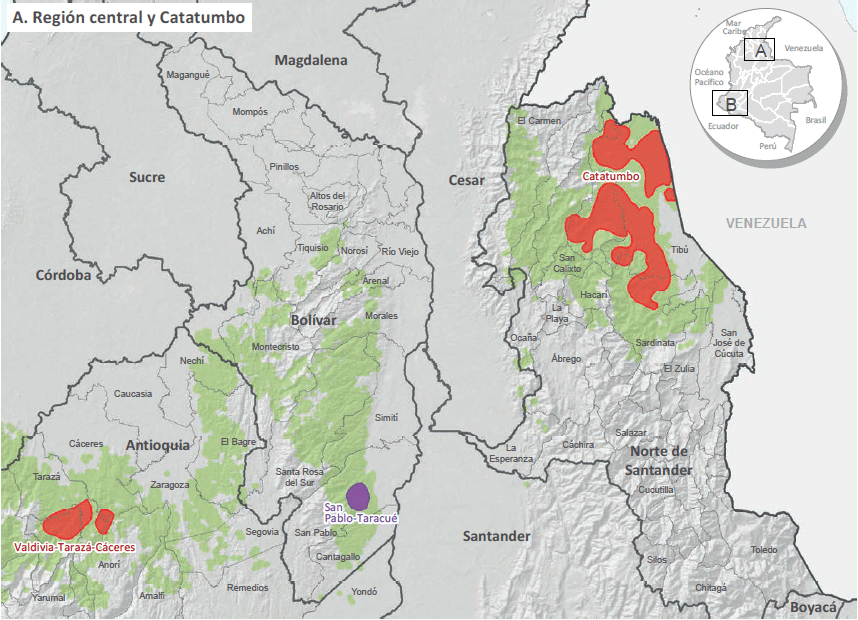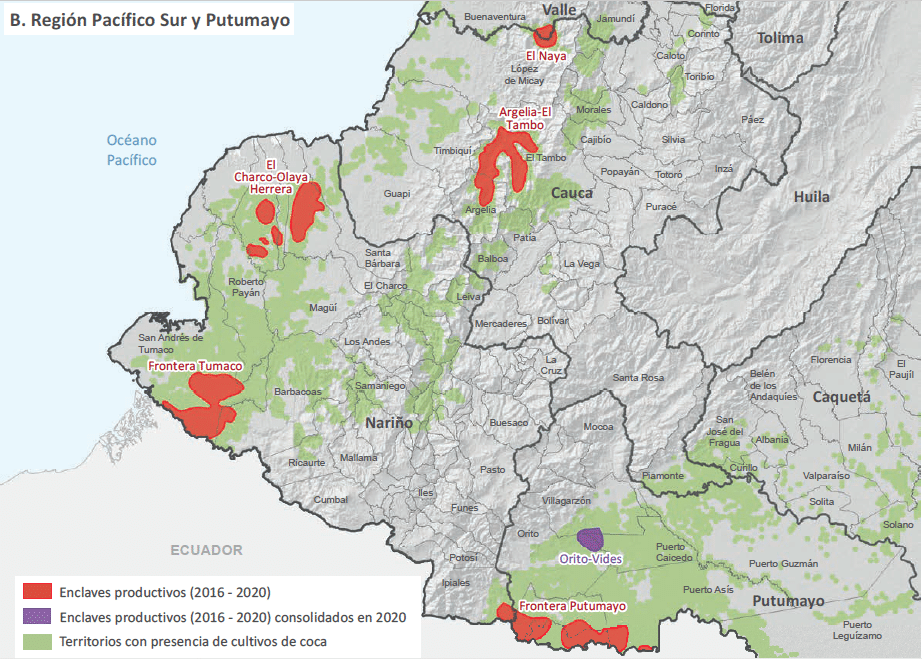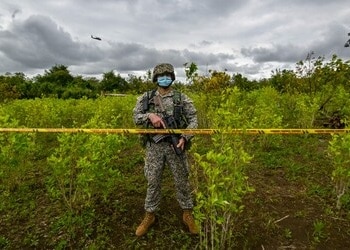While the amount of coca crops in Colombia has dipped for the third year, the country’s cocaine production continues to reach record highs, according to new figures from the United Nations.
Some 1,228 metric tons of cocaine were produced in 2020. That’s a nearly eight percent increase from 1,136 tons last year, according to a new report by the Illicit Cultivations Monitoring System (Sistema Integrado de Monitoreo de Cultivos Ilícitos — SIMCI) of the United Nations Office on Drugs and Crime (UNODC). Meanwhile, the land used to produce coca crops in Colombia dropped to 143,000 hectares in 2020, a seven percent decrease from 2019.
While the trends may appear perplexing, there are reasons – technical, territorial and criminal – that coca and cocaine figures may plausibly be at odds.
Megalabs and New Production Methods
The amount of powdered cocaine extracted from a single hectare of coca increased by more than one kilogram in just a year.
Potential cocaine output jumped from 6.7 kilograms per hectare in 2019 to 7.9 kilograms in 2020, according to the UNODC report.
Three factors are possibly allowing traffickers to produce more cocaine from less coca acreage: larger production facilities, better sowing techniques and more cocaine being extracted from leaves.
In the past two years, Colombia’s armed forces have dismantled what anti-drug officials call “mega-laboratories.” These large campsites – able to produce several tons of cocaine – had previously been eschewed in favor of rudimentary sites to avoid detection by authorities.
Among the complexes discovered last year included two with enclosures dedicated to various stages of cocaine processing: warehousing coca leaves, their extraction into paste, and then the production of cocaine hydrochloride, the main ingredient in cocaine. One of the facilities was able to produce up to five tons of cocaine per month.
The massive drug labs were found in coca-rich regions of Nariño, on the southern border with Ecuador, and Catatumbo, on the eastern border with Venezuela. Both were linked to the National Liberation Army (Ejército de Liberación Nacional – ELN), Colombia’s last remaining guerrilla force. The group has taken over a large portion of cocaine production that was once in the hands of the Revolutionary Armed Forces of Colombia (Fuerzas Armadas Revolucionarias de Colombia – FARC), which demobilized in 2016 after coming to a peace agreement with the government.
In addition to the large production sites, advancements in coca cultivation and extraction techniques may be providing traffickers higher yields of cocaine.
Specific coca varieties may “increase the efficiency of cocaine extraction” or produce “a greater amount of cocaine in the leaf,” investigators with the UNODC write in their report, adding that both situations “need to be studied in depth.”
In its report from last year, the UNODC had noted a trend toward increasingly sophisticated production processes, as well as “techniques to get more coca from fewer leaves.”
Concentration of Coca Crops
Nearly 85 percent of coca in Colombia is grown in just five departments, according to the UNODC, and four of these are in remote, lawless border regions that are crucial drug trafficking routes.
The departments of Putumayo, Cauca and Nariño all sit along Colombia’s border with Ecuador, which has become a crucial exit point for cocaine to the United States and Europe.
Meanwhile, Norte de Santander, along the Venezuela border, is one of the most fertile grounds for coca. There, a single municipality, Tibú, accounts for 13 percent of the national total of coca cultivation, with nearly 20,000 hectares.
This mountainous jungle region is home to several armed groups, including the ELN and dissident FARC cells. Gasoline — needed for cocaine production — is commonly contrabanded in the region.


Coca cultivation is also concentrated in protected regions, which are difficult for authorities to access. Over half of all coca crops are located in Special Management Areas (Zonas de Manejo Especial), covering Indigenous reserves, Afro-Colombian communities and natural parks, according to the UNODC.
Replanting and Hidden Crops
Coca cultivation and cocaine production are notoriously hard to detect.
The White House’s Office of National Drug Control Policy, which also reports on coca crops in Colombia, described 245,000 hectares under cultivation in 2020. That’s 102,000 hectares more than the 143,000 hectares reported by the UNODC.
SEE ALSO: Half of All Destroyed Coca Crops Replanted in Colombia
According to the White House, cocaine production capacity rose to 1,010 metric tons — about 200 tons less than the UNODC’s tally.
The reasons for the discrepancies are unclear, but this is the second year in a row in which the numbers have diverged sharply.
One factor could be high levels of replanting coca crops. Coca farmers have long replaced coca immediately after eradication to recoup their losses. Criminal groups also have been known to force farmers to sow more coca. Miguel Ceballos, Colombia’s High Commissioner for Peace, said in 2019 that replanting occurred at a rate of between 50 and 67 percent.
And coca eradication numbers can be unreliable. A 2020 exposé by Semana revealed that Colombia’s government may have been inflating the amount of coca crops destroyed by up to a third. Coca eradicators contracted by Colombia’s military told the news outlet that they often come up against angry farmers when they remove their crops, so they often compromise with them, agreeing to cull just half.
Colombia President Iván Duque, meanwhile, has sought to restart the aerial spraying of coca. Several years ago, the country’s Constitutional Court restricted the use of the herbicide glyphosate by aircraft, citing health concerns. The Ministry of Defense appears ready to resume spraying imminently after meeting certain conditions set by the court, though challenges are still pending.
Farmers are already adept at avoiding fumigation by hiding coca crops under banana plants and other vegetation. And traffickers could also respond to resumed aerial spraying by using more remote and smaller coca plots, pushing plantings further into reserves or onto territory that is harder to spray.
In the Meta department, home to the Sierra de La Macarena National Park, a mountain forest reserve of some 629,000 hectares, traffickers pay to have single hectares of forest cleared. The isolated plots are more difficult to spot by helicopter.

